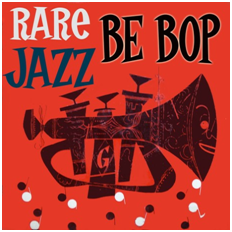

Near the end of the World War II, a new type of jazz began to emerge. The new jazz was classified by the characteristic way many of the jazz musicians ended their musical phrases while playing a solo. Bebop was the sound that was often heard at the ends of the phrases and the name that eventually would classify the first steps away from the Big Band and Swing eras toward modern jazz. This was one of the first major changes of jazz history and one that led to numerous forms of music, including Rock and Roll and Hip Hop. This new style of jazz, known as Bebop, was not initially liked by the public, nor by the traditional jazz musicians of the 1940s. Swing music was so popular that it would take some very talented and passionate musicians to break down the barriers of what was accepted musically during this time. There were several major differences in the music that caused the lack of acceptance in popular culture. First, the ensembles shrank in size from over 20 musicians in a typical big band to 4 or 5 musicians. A typical Bebop ensemble consisted of a trumpet, saxophone, piano, bass, and drum set.
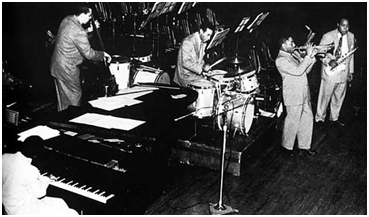
The second reason dealt with the increase in the amount of improvisation utilized in most of the music. The typical audience that was used to dancing to swing music found that they couldn’t dance to this type of music and also found it difficult to remember the melodies of each song. Music had switched from strictly entertainment to “art music.” This new music found its roots in New York City. Musicians would stay after their normal big band performances to “jam” with each other and challenge each other musically. They would take well-known, popular songs and use them as the basis for the creation of new songs built predominately with improvisation. The tempos of these songs were very fast and challenged the musicians. Tempo is a musical term that determines how fast or slow to play a particular piece of music. The musicians would also change the scale patterns and chord structure of the music to make them even more challenging. Minton’s Playhouse in Harlem New York can be considered the main home to the creation of Bebop.
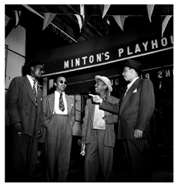
The founding fathers of Bebop are considered to be trumpet player Dizzy Gillespie; saxophonist Charlie Parker; pianists Thelonius Monk and Bud Powell; and drummer Max Roach. Dizzy Gillespie and Charlie Parker met while playing in a big band in 1942. Numerous issues, including the economy and racial tensions, where forcing black musicians into smaller ensembles and out of the big band setting. Integrated ensembles and high paying jobs where hard to come by for many black performers during the 1940s and this new modern music provided artists with an avenue to escape with their music. Bebop was considered to be “black” music, and therefore faced many obstacles throughout this time period. Dizzy and Charlie, however, are considered to be two of the best musicians in all of jazz history. They were considered to be virtuosos on their instruments, which would eventually begin to breakdown racial barriers as people wanted to hear the very best! These two jazz legends formed their own small band and began to promote this form of modern jazz to the world.
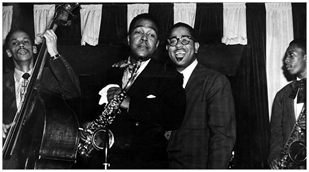
Bebop History Video:
Bebop was slowly starting to become a part of popular culture and evolve into a “counter-culture.” The BeBop generation was the first real “hipster” generation with the way they talked, dressed, and played their music. Thick-rimmed glasses, berets, and dark nightclubs became the trend with the younger generation as this new culture struggled to find a place in society. Dizzy and Charlie began to inspire and mentor countless musicians throughout their travels. One of those musicians was a pianist named Thelonious Monk.
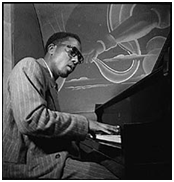
(1917-1982)
Thelonious Monk was a gifted pianist at a very young age. He learned how to read music before he had any type of formal music education and was touring as an organist with a religious group by his teenage years. Thelonious eventually found his way to Minton’s in Harlem where he met up with the Dizzy Gillespie and Charlie Parker to help create this new type of jazz known as BeBop. Forming his own small band while making recordings, Thelonious set out on performance tours throughout America and Europe. He became so popular and respected over the next decade that he became one of only a handful of jazz artists to be featured on the cover of Time Magazine. Musically he is known as one of the greatest jazz pianists of all time.
Suggested Listening: Don’t Blame Me – Thelonious Monk
Another Bebop innovator associated with the founding fathers of this art form is considered to be one of the greatest drummers of all time. Max Roach changed the way the drum set was used in Bebop ensembles.
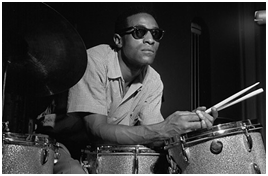
(1924-2007)
Max Roach was one of the leading drummers of the Bebop era and changed the way the instrument was perceived within the jazz genre. The drum set evolved from merely a time keeping device to an important solo instrument and Max Roach was at the forefront of this important development. Max gre up in New York, and was surrounded by jazz and many important performers. Inspired by gospel music, he began playing the drums at the age of ten and was playing in Duke Ellington’s band by the time he was sixteen. The major change that Max fostered while playing the drums came about due to the nature and speed of Bebop. No longer could a drummer just keep time with the bass drum or largest drum on the drum set. The speed of the music was too fast. Max found that he could still keep time by playing the high hat and accenting with the bass drum. Those accents became known as “dropping bombs” in a musical setting. The drum set became a melodic instrument and could change the sound of each musical selection. The two selections below demonstrate Max Roach and his amazing ability on the high hat along with an example of his ground breaking drum solos.
High hat:
Drum Solo:

Below are additional educational resources and activities for this unit.
Unit 6 BeBop (Fill in the Blank) Worksheet
Unit 6 Cornell Notes Worksheet